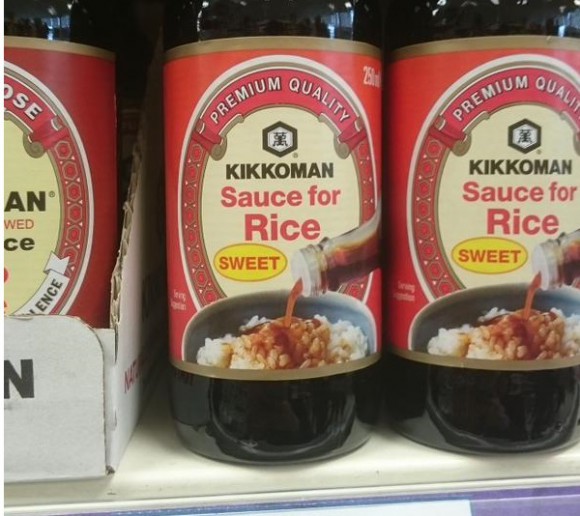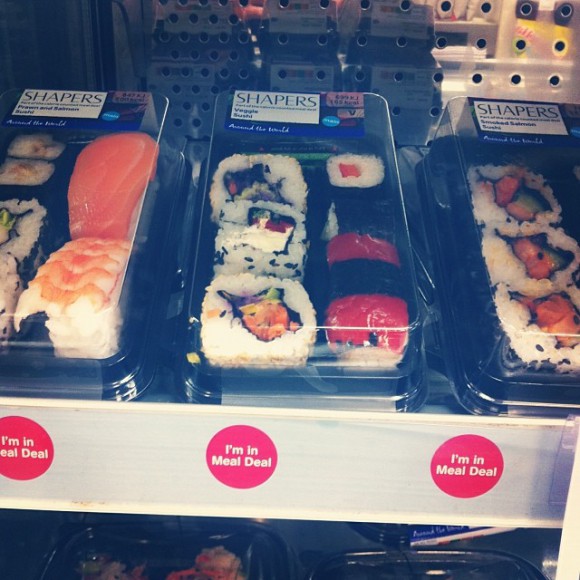
One of the first things that foreign visitors to Japan learn about Japanese cuisine is that white rice served by itself is meant to be enjoyed as it is, not soaked in soy or doused in dipping sauce. But many people who aren’t all that well-acquainted with Japanese food find the taste of plain boiled rice bland, and love to drizzle sweet and salty sauces all over in order to jazz it up a bit, even if it does make eating it with chopsticks ten times harder.
The UK is one place that probably isn’t known for having a high level of familiarity with Japanese food. Chains like Wagamama and Shoryu Ramen do exist, but they tend to play fast and loose with the definition of Japanese food, and as a result many British diners wind up getting their tastebuds in a bit of a tangle. But now, Japanese company Kikkoman is actually encouraging this desecrating behaviour by bringing out a new product in the UK market: Kikkoman Sweet Sauce for Rice! As you might expect, it’s raising eyebrows in Japan.
A Japanese tweeter recently posted a picture of a shop shelf in the UK which carries the product:
https://twitter.com/sheena_rat/status/647528357719097344“Foreigners seem to enjoy covering white rice in sauce, so Kikkoman have brought out a range of sauce to take advantage of that”, writes the tweeter, and this certainly seems like a savvy savoury move on Kikkoman’s part. In fact, most supermarkets in the UK usually have a tiny Japanese ingredients section which is almost always dominated by Kikkoman’s products, plus little boxes of sushi rice and nori seaweed so you can whip up sushi rolls at home. Gotta have all the basics, right?
Get your hands on our range of authentic #Japanese #ingredients, now on offer at @Sainsburys! pic.twitter.com/CEDZPGyy2P
— Yutaka (@YutakaEats) September 22, 2015
Sometimes, though, things just go badly wrong, like this “Japanese ramen” meal from British company Innocent, in which the noodles are actually udon…
Our new noodle pots are all £1 off in Tesco and save 1/3 in Sainsbury's right now http://t.co/5KqHcf9UlA pic.twitter.com/Tk9IBeonnu
— innocent drinks (@innocent) June 11, 2013
And this roasted red pepper sushi (although maybe Japan is a little late to the party on that front?).

However, it seems that Kikkoman is trying to encourage British shoppers to use the sauce in a variety of frankly weird ways. On the official European Kikkoman website, an explanation for the saucy product states:
“Our Sauce for rice adds a unique sweet-savoury flavour to all kinds of dishes, from meat and vegetables to soups and salads. It is perfect for the caramelisation of vegetables or nuts and it adds a special flavour nuance to Sunday roasts because just a few spoonfuls used as a marinade produce a beautifully crispy and incredibly delicious result. Sauce for rice even enriches the flavour of desserts such as chocolate mousse.”
Sunday roast? Chocolate mousse? Have you gone mad, Kikkoman?
Still, many Japanese commenters decided to go easy on the sauce, with some even expressing an interest in trying it out themselves:
“I didn’t know foreigners like to put soy sauce on rice. I’ve never seen it…”
“I actually really want to try this!”
“This is a yummy way to eat rice, which an American friend taught me about.”
“Foreigners don’t know to take a bite of white rice and then a side dish, so they think that white rice needs sauce mixed in.”
“It’s not that different to tamago-kake gohan, (raw egg and soy sauce mixed into hot rice) when you think about it.”
“Why is it sweet? Is it just soy sauce with sugar in it?”
“Soy sauce and butter on rice is yummy.”
We’ve been noticing a trend of late for Japanese netizens to enthusiastically construct disgusting food concoctions, so perhaps it’s better to take the opinions of Japanese Twitter users with a pinch of salt (and a dash of soy sauce). Traditional Japanese chefs would probably still balk at the idea of doctoring white rice. Still, perhaps in years to come “Saucy Rice” will be considered an essential British Japanese dish. After all, if the British hadn’t taken their own version of curry over to Japan, the Japanese curry rice we know today would never have been invented. And if American eaters didn’t have such an affinity for turning food inside out, we wouldn’t have California rolls! Perhaps we should embrace new food trends and the merging of different culinary cultures. After all, it’s all the same once it’s inside your stomach, anyway.
Source: Yukawa Net, Twitter/@sheena_rat
Main Image: Twitter/@sheena_rat

 Can our Japanese writers guess what this pink soy sauce is by taste alone?【Video】
Can our Japanese writers guess what this pink soy sauce is by taste alone?【Video】 Ginger ale flavored soy milk coming to Japanese stores, buckets sold separately
Ginger ale flavored soy milk coming to Japanese stores, buckets sold separately Japanese people reveal the six western foods they find most disgusting
Japanese people reveal the six western foods they find most disgusting Disney soy sauce is now on sale in Japan—four different tastes, four cute designs
Disney soy sauce is now on sale in Japan—four different tastes, four cute designs Transparent soy sauce is a thing — we saw it, we tried it, we’re confused by it
Transparent soy sauce is a thing — we saw it, we tried it, we’re confused by it Japan’s new difficult-to-drink-from beer glass protects your liver, but it’s a brutal experience
Japan’s new difficult-to-drink-from beer glass protects your liver, but it’s a brutal experience How to order snacks on a Shinkansen bullet train in Japan
How to order snacks on a Shinkansen bullet train in Japan Demon Slayer: Kimetsu no Yaiba gets new roller coaster attractions and food at Universal Studios Japan
Demon Slayer: Kimetsu no Yaiba gets new roller coaster attractions and food at Universal Studios Japan New Pokémon ice cream, dessert drinks, and cool merch coming to Baskin-Robbins Japan【Pics】
New Pokémon ice cream, dessert drinks, and cool merch coming to Baskin-Robbins Japan【Pics】 Burger King Japan suddenly adds Dr. Pepper and Dr. Pepper floats to its menu nationwide
Burger King Japan suddenly adds Dr. Pepper and Dr. Pepper floats to its menu nationwide Hello, cosmetics! Clinique teams up with Hello Kitty this summer for first-time collaboration
Hello, cosmetics! Clinique teams up with Hello Kitty this summer for first-time collaboration “The most Delicious Cup Noodle in history” – Japan’s French Cup Noodle wins our heart【Taste test】
“The most Delicious Cup Noodle in history” – Japan’s French Cup Noodle wins our heart【Taste test】 To combat declining birth rate, Japan to begin offering “Breeding Visas” to foreigners
To combat declining birth rate, Japan to begin offering “Breeding Visas” to foreigners Starbucks teams up with Japanese shochu brewery for a whole new coffee experience
Starbucks teams up with Japanese shochu brewery for a whole new coffee experience Studio Ghibli releases giant Totoro plushies in Japan
Studio Ghibli releases giant Totoro plushies in Japan Nintendo history you can feel – Super NES, N64, and GameCube controllers become capsule toys
Nintendo history you can feel – Super NES, N64, and GameCube controllers become capsule toys Starbucks releases a cute Frappuccino and Unicorn Cake…but not in Japan
Starbucks releases a cute Frappuccino and Unicorn Cake…but not in Japan Kyoto Tower mascot termination reveals dark side behind cute Japanese characters
Kyoto Tower mascot termination reveals dark side behind cute Japanese characters McDonald’s Japan’s Soft Twist Tower: A phantom ice cream only sold at select branches
McDonald’s Japan’s Soft Twist Tower: A phantom ice cream only sold at select branches Yabai Ramen: What makes this Japanese ramen so dangerous?
Yabai Ramen: What makes this Japanese ramen so dangerous? Finally! Nintendo Japan expands Switch 8-bit controller sales to everybody, Online member or not
Finally! Nintendo Japan expands Switch 8-bit controller sales to everybody, Online member or not Japanese government wants to build luxury resorts in all national parks for foreign tourists
Japanese government wants to build luxury resorts in all national parks for foreign tourists 10 things you should buy at 7-Eleven in Japan
10 things you should buy at 7-Eleven in Japan Studio Ghibli releases anime heroine cosplay dresses that are super comfy to wear
Studio Ghibli releases anime heroine cosplay dresses that are super comfy to wear Woman charged for driving suitcase without a license in Osaka
Woman charged for driving suitcase without a license in Osaka Studio Ghibli unveils My Neighbour Totoro miniature house model
Studio Ghibli unveils My Neighbour Totoro miniature house model Kyoto experiencing problems with foreign tourists not paying for bus fares, but not on purpose
Kyoto experiencing problems with foreign tourists not paying for bus fares, but not on purpose Fighting mild hunger with a Japanese soda that turns into jelly in the stomach【Taste test】
Fighting mild hunger with a Japanese soda that turns into jelly in the stomach【Taste test】 Studio Ghibli’s Howl’s Moving Castle tapestry unveiled in Japan for first time
Studio Ghibli’s Howl’s Moving Castle tapestry unveiled in Japan for first time McDonald’s new Happy Meals offer up cute and practical Sanrio lifestyle goods
McDonald’s new Happy Meals offer up cute and practical Sanrio lifestyle goods Sales of Japan’s most convenient train ticket/shopping payment cards suspended indefinitely
Sales of Japan’s most convenient train ticket/shopping payment cards suspended indefinitely Sold-out Studio Ghibli desktop humidifiers are back so Totoro can help you through the dry season
Sold-out Studio Ghibli desktop humidifiers are back so Totoro can help you through the dry season Japanese government to make first change to romanization spelling rules since the 1950s
Japanese government to make first change to romanization spelling rules since the 1950s Foreigner’s request for help in Tokyo makes us sad for the state of society
Foreigner’s request for help in Tokyo makes us sad for the state of society Ghibli founders Toshio Suzuki and Hayao Miyazaki contribute to Japanese whisky Totoro label design
Ghibli founders Toshio Suzuki and Hayao Miyazaki contribute to Japanese whisky Totoro label design Doraemon found buried at sea as scene from 1993 anime becomes real life【Photos】
Doraemon found buried at sea as scene from 1993 anime becomes real life【Photos】 Tokyo’s most famous Starbucks is closed
Tokyo’s most famous Starbucks is closed Princesses, fruits, and blacksmiths: Study reveals the 30 most unusual family names in Japan
Princesses, fruits, and blacksmiths: Study reveals the 30 most unusual family names in Japan Gamer-friendly, non-instant yakisoba you can eat with your fingers【Sora Kitchen】
Gamer-friendly, non-instant yakisoba you can eat with your fingers【Sora Kitchen】 What does vegan ramen taste like? We try Veggie Brown Rice Ramen
What does vegan ramen taste like? We try Veggie Brown Rice Ramen Drip-brewed drinkable soups developed by Japanese soy sauce giant
Drip-brewed drinkable soups developed by Japanese soy sauce giant Should you add wasabi to your soy sauce at a sushi restaurant?
Should you add wasabi to your soy sauce at a sushi restaurant? Something for soy milk skeptics: cola and pear flavors
Something for soy milk skeptics: cola and pear flavors McDonald’s Japan’s Samurai Mac series: which burger is the greatest warrior of all?
McDonald’s Japan’s Samurai Mac series: which burger is the greatest warrior of all? Onikun: Epic onigiri so big they’re half demon, half rice ball
Onikun: Epic onigiri so big they’re half demon, half rice ball Trying some Umui sauces made only on a remote Japanese island with a population of 50【Taste test】
Trying some Umui sauces made only on a remote Japanese island with a population of 50【Taste test】 Beautiful red soy sauce from Japan uses no artificial colors, tastes like nothing else
Beautiful red soy sauce from Japan uses no artificial colors, tastes like nothing else Japanese restaurant chain shows us how to make katsudon in three minutes【SoraKitchen】
Japanese restaurant chain shows us how to make katsudon in three minutes【SoraKitchen】 How to eat sushi like a sensei 【Video】
How to eat sushi like a sensei 【Video】 Is it OK to put other food on top of your white rice when eating in Japan?
Is it OK to put other food on top of your white rice when eating in Japan? Now there’s chocolate-flavored soy sauce…for shaved ice!
Now there’s chocolate-flavored soy sauce…for shaved ice! We try black rice sushi rolls in Australia
We try black rice sushi rolls in Australia McDonald’s Japan brings out a new chicken burger with rice buns
McDonald’s Japan brings out a new chicken burger with rice buns
Leave a Reply